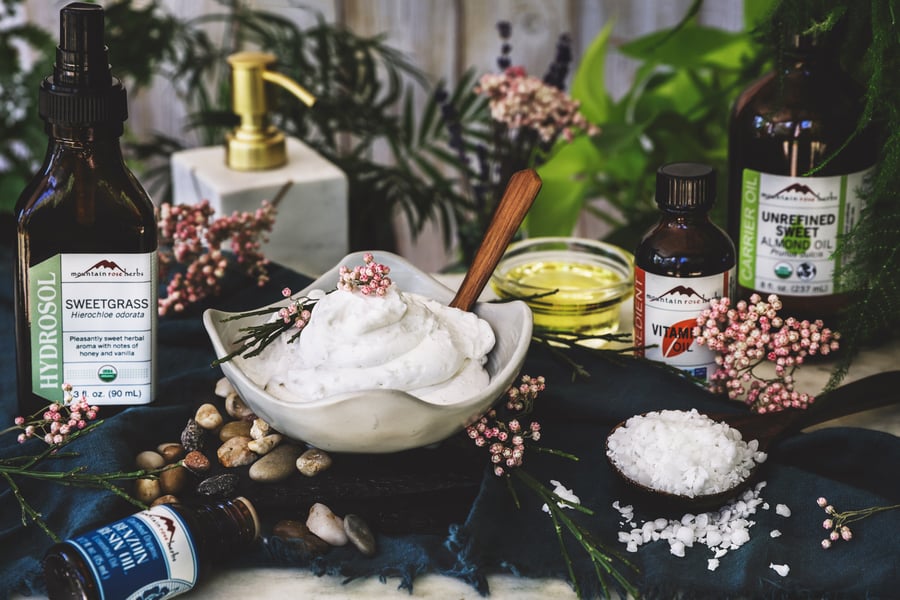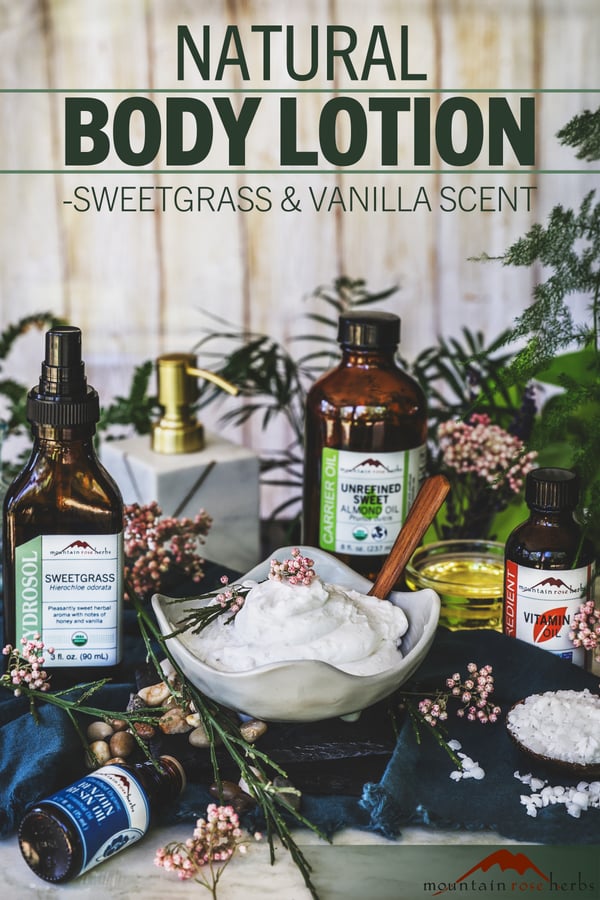Perhaps every herbalist or skincare formulator has a recipe that once wholly intimidated them. Homemade lotion was one of those for me. I had a pretty epic and expensive DIY lotion fail once, and it took me a long time to build up enough confidence to try blending water and oil into something usable again. Mountain Rose’s organic sweetgrass hydrosol was the impetus to suck up my courage and try again. Its subtle, honeyed aroma has a wonderfully green-earth undertone that makes it a perfect base for a variety of skincare formulations, from facial toners to body sprays to lotions. In this simple lotion recipe, I love it with just a touch of vanilla in the form of organic benzoin resin.
Humans have been cultivating sweetgrass (Hierochloe odorata) for over 6,000 years, and it has a long history of spiritual use: strewn on the floors of Medieval churches in Europe and considered one of the four sacred herbs by First Nations peoples in North America. Sometimes called the “hair of Mother Earth,” sweetgrass is said to please the spirits and is an excellent choice to prepare spaces for prayer, ritual, and meditation. In its hydrosol form, I find it has that same “clearing” element to its scent; it resets my mind and opens my heart.
A note about equipment: It turns out that the cause of my previous lotion-making failure was that I used the wrong tool. I didn’t own an immersion blender, so I tried to use a regular blender. I suggest you spare yourself that particular pain. A hand mixer will work, but a hand mixer is intended to beat air into a batter, and you really don’t want to beat air into your lotion. There is a way around this issue if you only have a hand mixer (more on that in the directions). I finally purchased an inexpensive immersion blender (cost me $18.00) for my apothecary and it has been life-changing.
Also note that this recipe is for personal use and should be made only in small batches that you can use within about 3 months because it involves water in the form of hydrosol and does not have a preservative. Store the bulk of the lotion in the refrigerator—if properly made and stored, it will last 3-4 months. Use a sterile rubber spatula or spoon, take out what you need for 1-2 weeks at a time, and put that amount in a pump bottle that you store in a cool place away from light and temperature fluctuations. Don’t use your fingers to scoop the lotion, or you will potentially introduce contaminants that can make it go bad more quickly. If the lotion starts to separate or smell off, discard it and make new.
DIY Lotion: Sweetgrass and Vanilla
Makes about 1 1/2 cups.
Ingredients
- 2/3 cup organic sweetgrass hydrosol
- 3 Tbsp. organic jojoba oil or refined sweet almond oil
- 1 Tbsp. organic refined shea butter
- 4 tsp. emulsifying wax
- 4 tsp. stearic acid
- 1 1/2 tsp. organic vegetable glycerine
- 1/8 tsp. non-GMO citric acid (optional, but it ensures a proper pH)
- 1/2 tsp. non-GMO vitamin E oil
- 1/2 - 1 tsp. organic benzoin resin oil (optional)
Directions
- Arrange a double boiler with several inches of water in the bottom. Set over medium heat.
- Combine hydrosol, oil, shea butter, emulsifying wax, stearic acid, vegetable glycerine, and citric acid in the top of the double boiler.
- Heat hydrosol mixture, stirring regularly with a rubber spatula, whisk, or another non-reactive tool, until everything is completely melted and combined. You want to make sure there are no remaining bits of wax, etc. Mixture will heat to about 170°F. It's okay if it gets a little hotter, but do not let the mixture come to a boil!
- When everything is melted and incorporated, pour into a medium (3-4 cups) bowl and let cool to about 160°F.
- Use an immersion blender or hand mixer at approximately medium speed to blend (they are all different, so do what makes the most sense for your model). Make sure the beater is submerged as deeply as possible in the mixture so you don’t create a lot of bubbles and foam. Blend for 1-2 minutes. Then use a clean rubber spatula or wooden spoon to vigorously stir down any resulting bubbles or foam and reincorporate them into the mix. Scrape down the sides.
- Test the temperature of your mix. When it has cooled to about 110°F, add vitamin E oil and benzoin resin oil.
- Use the immersion blender again, fully submerged, for another couple of minutes. Repeat the stirring-down process with the spatula or spoon. Repeat the immersion blender and then hand-stirring a few times, until you have achieved a thickened lotion consistency. This takes about 5 minutes. You should be able to lift the blender or spoon and the lotion will fold over and leave a track (as opposed to being so liquid that it reincorporates smoothly into the lotion), but it should not be so thick that you can create peaks. It will thicken more as it cools.
- Pour your lotion back-stock into a sterile container with an airtight lid, label it with the name of the lotion and the date made, and store in refrigerator. Take out only as much lotion as you will use in the next week and put into a small, sterile bottle with a pump top. Label, and store in a cool place away from direct light and heat fluctuations for easy day-to-day use. Always store the rest in the refrigerator. If properly made and stored, the back-stock will last 3-4 months.
Pro Tips
- You can use distilled water in place of the hydrosol. Because tap water varies significantly, and can throw off the pH in lotions, I avoid using it.
- To make a heavier body lotion, use olive oil or avocado oil in place of almond or jojoba oil.
Are you interested in taking your lotion-making to the next level?
Check Out This Emulsifiers and Preservatives Intensive From Our Friends at The Herbal Academy!
You may also enjoy:
- Triple Rose Moisturizing Face Cream Recipe
- Gentle Floral Skin Cream Recipe
- Arnica Hand Balm Recipe for Hard-Working Hands












